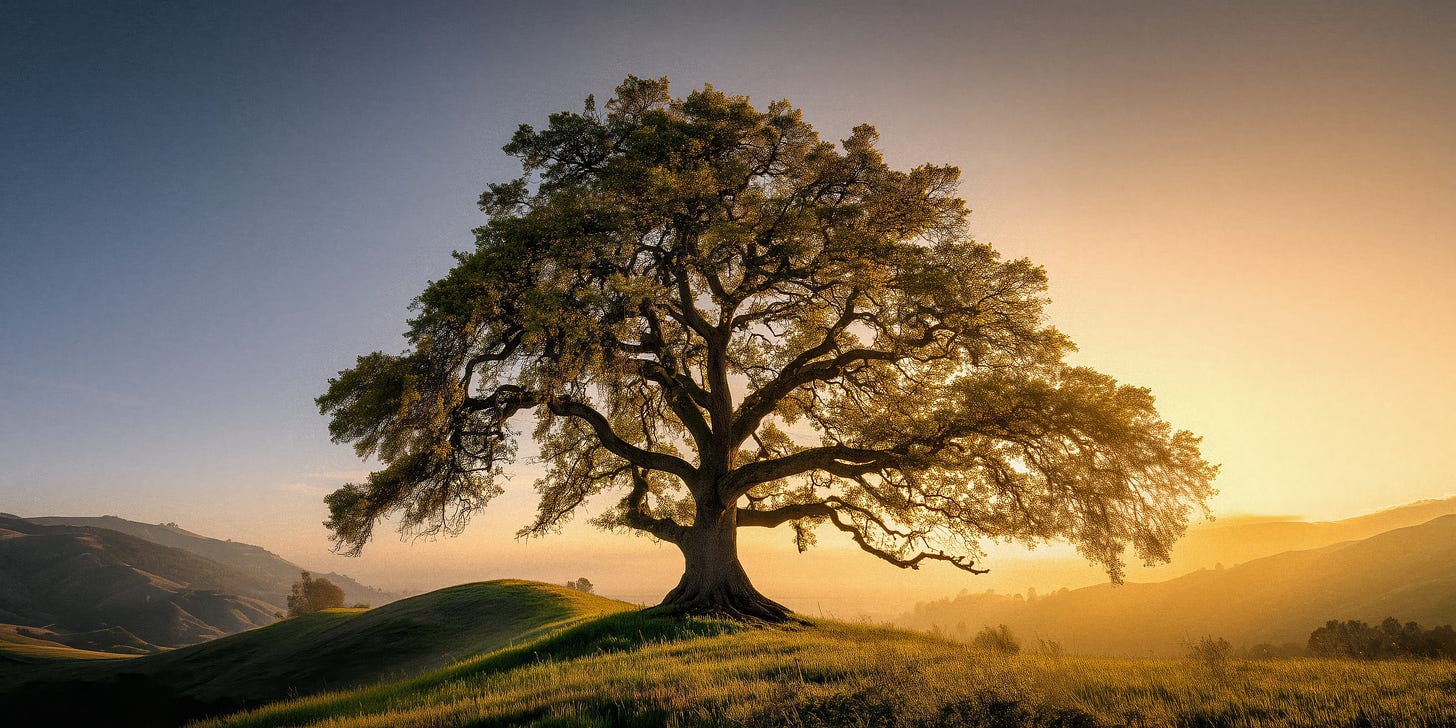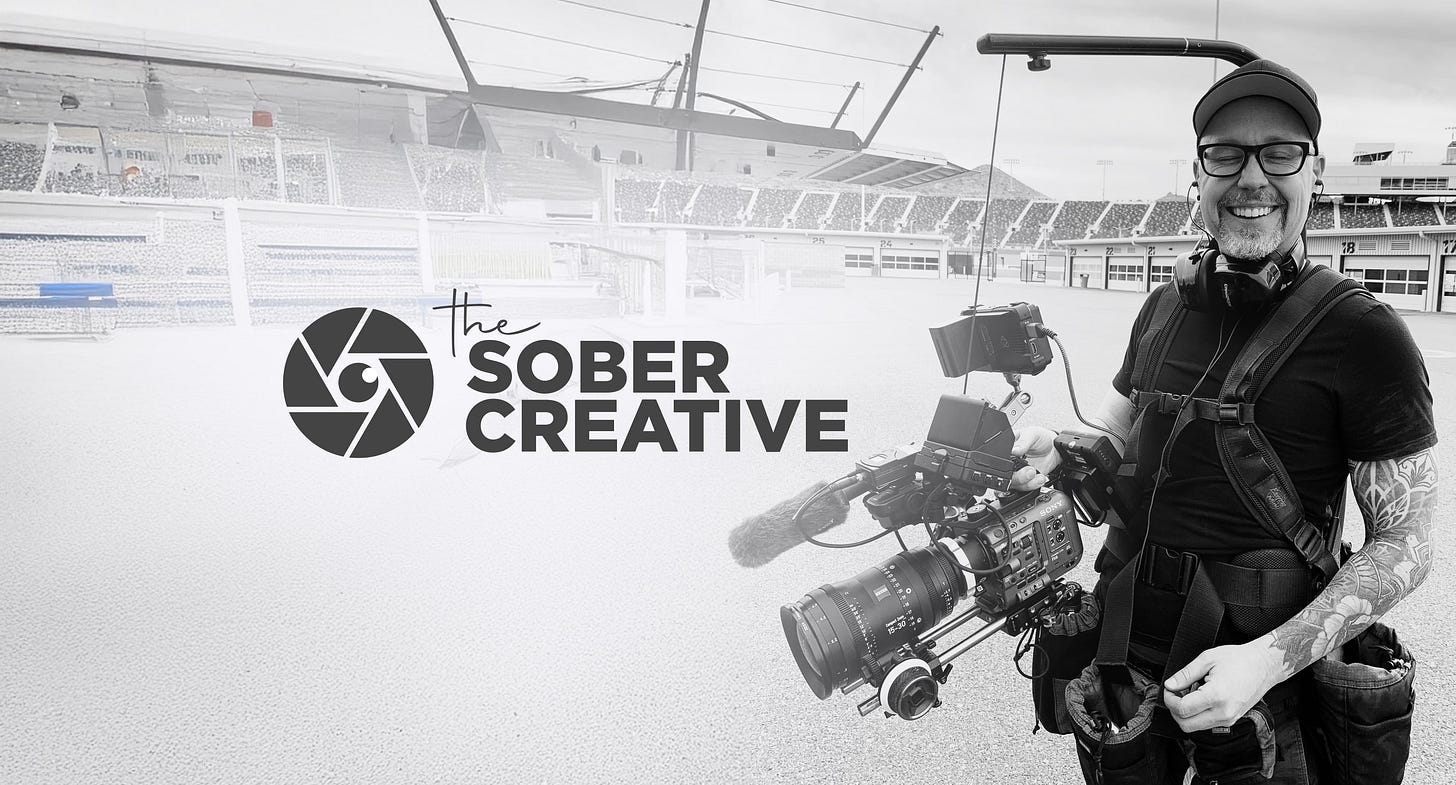Building Creative Resilience in Sobriety: The Oak Tree Metaphor for Artists
Rooted in Strength—How Sobriety Nurtures Creative Growth and Endurance
There it stands—still standing, still being.
Through wind and rain, storms and snowfall, darkness and light.
Through the seasons, it manages to die and be reborn as a slightly different version.
Each day brings an interconnectedness. Its roots grow deeper within the earth.
You can't help but feel its awe when you're in the presence of an oak tree.
Rooted in Discipline
If I were to emulate or learn from being an oak tree, it would teach me about my sobriety—about abstaining, about saying no when needed. About building discipline in how I treat myself through food, exercise, sleep, and mind.
These practices are interconnected like the roots of the tree. They serve one another. When I get quality rest, I can work harder in the gym. When I meditate, I can be more present in conversations with friends or family. I can place nourishing food in my body which gives me more energy. All of this allows creative ideas to flow more easily.
Unlike the oak's stable root system, alcohol severed these connections. One night of drinking wouldn't just affect that evening—it would cascade through my systems like rot spreading through roots. My sleep would suffer, making exercise forgettable. Nutrition would be replaced with comfort foods to ease the hangover. Creative work would diminish.
The oak doesn't poison its own soil, yet that's exactly what I was doing to myself.
Standing in Discomfort
Each day I wake, there will be a challenging situation to face.
How can I be like the oak and stand in this discomfort?
The oak cannot retreat from harsh weather or seek shelter from the storm. It has to stand firm through centuries of challenges, developing strength through resistance rather than avoidance.
In sobriety, I practice this same resilience. When cravings arise—I don't run from the discomfort—I stand in it, observe it, let it pass through me like wind through branches. When difficult emotions surface, I've learned to be present with them rather than numbing them away. This presence doesn’t always come naturally. It’s a practice I cultivate daily—through meditation, through breathing, through reminders that discomfort, like seasons, is temporary.
The oak tree witnesses the beauty of each sunrise and sunset, the moon's journey across the sky, birds building nests and raising their young. It doesn't judge or intervene—it simply stands as a steady presence, offering support through its very being. I've learned this kind of quiet strength - to practice observing without needing to control, to support without needing to fix, to be present without needing to perform.
Unlike my drinking days, when I'd escape at the first sign of discomfort, now I recognize that growth happens in these very moments of challenge.
Weathering the Storms
Storms will come. Days of doubt, moments of craving, situations that test my resolve. The oak doesn't run from the storm—it has developed the strength to weather it.
These storms take many forms, each testing a different aspect of my foundation. The shame when I first declined drinks with friends. The isolation that followed as I withdrew from settings centered around alcohol. Loneliness that filled those newly empty spaces. The most challenging storm to this day is the need for external validation—unlike the oak that draws nourishment from within its own roots, alcohol created a false sense of believing in myself.
The oak prepares for storms long before they arrive, growing support structures that maintain stability when challenges emerge. I've developed similar systems that keep me grounded. My morning meditation, my physical training, my creative practice—the roots that hold me steady when everything else seems uncertain.
When lightning strikes an oak, the tree may lose branches or bear scars, but it adapts and continues growing around the damage. Similarly, I've learned that setbacks in sobriety don't mean failure. If I slip or struggle, I don't abandon my entire foundation—I assess the damage, adapt my approach, and continue growing with newfound knowledge.
In my drinking days, I was more like a vine—flexible but fragile, easily torn when storms came, wrapping around something for support. Alcohol created the illusion of weathering storms while actually making me more vulnerable to them.
The oak's strength isn't in avoiding difficulties but in developing the resilience to stand firm through them.
Rings of Abundance
Each year, an oak adds another ring to its trunk— a visible record of its journey. Some rings are wider, representing years of abundance. Others are thinner, marking times of scarcity or challenge.* Yet each ring becomes part of the tree's foundation, strengthening it for what comes next.
My sobriety journey has similar rings—periods of growth, moments of challenge, seasons of transformation. Each experience, whether difficult or joyful, becomes part of my foundation. The challenges I've overcome don't disappear—they become the very structure that allows me to expand further.
I'm not perfect—neither is the oak. Look closely and you'll see scars where branches have fallen, marks where lightning may have struck. These imperfections don't diminish its magnificence—they tell the story of its resilience.
In sobriety, I've learned to embrace my scars rather than hide them. They remind me of where I've been and how far I've come. They are proof that wounding doesn't have to be weakening—it can become a source of unique strength and character.
The oak doesn't question its purpose or compare itself to the maple or the pine. It simply grows as it was meant to grow, offering what it was designed to offer.
In sobriety, I've found similar peace in being authentically myself rather than trying to fit someone else's definition of success or creativity.
Still standing, still being—just as the oak has done for centuries before me.
*In dendrochronology (the study of tree rings), the width of a ring reflects the growth conditions during that year:
• Wider rings usually indicate favorable conditions—plenty of water, nutrients, sunlight, and a healthy environment. These are often interpreted as years of abundance.
• Thinner rings suggest less ideal conditions—drought, poor soil, cold temperatures, or disease. These can represent years of stress or scarcity.
What's Next
☀️ The Sober Creative is more than a newsletter.
It’s a movement—and now, a growing community of creatives choosing clarity.
✍️ Read the Essays (free)
Stories and strategies for building a clear, intentional creative life without substances.
🎙️ Join Clear Conversations (free)
Live interviews with artists and entrepreneurs navigating sobriety and deep creative purpose.
🧘 Try a Guided Meditation (free/paid)
Short, powerful practices to reconnect with your creative voice and ground your nervous system.
🌟 Go Premium (paid)
Support this work and unlock full access:
Extended guided meditations
Exclusive live meditation sessions
Priority Q&A and community insights
Become a paid subscriber for $8/month
👥 Founding Members (paid)
Founding members receive lifetime access, a 1:1 coaching session with me, and the opportunity to help shape the experience and future offerings of The Sober Creative—without changing its core mission.
Join as a founding member for $240/year
💬 Let’s connect
Book a free coffee chat if you’re curious about coaching, community, or just want to say hey.
🧭 Feeling ready?
Explore Unfiltered Creation — a 90-day 1:1 coaching experience to align your work, sobriety, and purpose.
Each step forward is an act of creative rebellion.
Thanks for walking this path with me.
Josh







This is absolutely beautiful Josh, your metaphor is relevant to so many aspects of life, the importance of self love and self healing, whatever the cause.